English translation by Melina Piccolo.
Camilla Boemio: The war in Ukraine, the hardships faced by the people there, the suffering we feel in the face of Russian aggression must always be remembered, be part of raising public awareness.
Mass protests in Tbilisi forced the withdrawal of a bill on “transparency of foreign influence” which threatened civil society organizations and media with ‘foreign agent’ status. The use of nonviolent acts of defiance were effective as a form of brave resistance and to change the prevailing political opinion. What are your thoughts on this?
Liudmila Vladova Olenovych: Unfortunately, we are living in a world full of wars and suffering. It has probably always been that way in the past too, but modern means of communication (and not only them), cause us to be increasingly more involved in the suffering of others. In the modern world it is hard to stay out of it-you are always, constantly involved and this creates fatigue, fear and the need to protect yourself and consequently disassociation from outside stimuli. This is what we are experiencing today in modern society.
Russian aggression against Ukraine is the concrete and direct result of such disassociation of the whole world from the issue of the geo/national, political ambitions of one country (Russia) directed toward another country (Ukraine).
Warnings pointing to what Ukraine is experiencing today date back to 2014 when Russia arrogantly seized Crimea before the eyes of the entire world, suffering only mild indignation as a public reaction, backed by a few, unimportant, sanctions.
The tragedy that my land and my people are experiencing in the present is the direct and dramatic consequence of such collective slumber.
Therefore, on the one hand, we must raise public awareness to remember that the suffering endured today by a people (e.g., Kosovo) should not be forgotten as such forgetfulness will undoubtedly give rise to tomorrow’s suffering, if we fail to draw an appropriate lesson from it. And, on the other hand, to draw the appropriate lesson from it we must raise public awareness so that we become definitely cognizant that all of us, all of Humanity, should feel responsible for the world we are living in.
Indifference to suffering produces even greater suffering, as the war in Ukraine shows.
The situation in Georgia offers very strong arguments for the need of public awareness as well as the need to firmly assert and defend one’s aspirations with dignity and determination, without the use of violence.
In this way they have shown us the path to a new world and a new way of living and defending our principles, upholding democratic values and becoming both their creators and beneficiaries in this very world.
This is precisely what our current reality is demanding of us today.
C.B.: How effective can exhibitions be in raising public awareness?
L.V.: YES, exhibitions can be very effective in raising public awareness because art conveys the pure essence of a culture, of a lived experience, of a vision of life and makes us touch the artist’s reality without filters and conditioning. This gives us the opportunity to become direct witnesses of an authentic reality, expressed through different artistic codes, enabling us to enter into deep contact with the artist and their message, taking us into another dimension of expression – outside of scenarios that are prepackaged or the fruit of very deliberate strategies.
Exhibitions create a space for intimate, personal and objective conversation, rich in food for thought, often placing a new perspective before the viewers.
C.B.: How to go about creating and giving form to a notion of collectivity that has a completely new meaning?
L.V.: I think this is an easy and difficult question at the same time. Easy, because it seems obvious, that to structure a notion of collectivity with a completely new connotation means to have already conveyed and consolidated a sense of personal responsibility in each individual for everything that happens in the modern world. It implies success in having conveyed through education and information tools all the awareness needed to exercise this new approach.
But then, the difficult question remains of how to bring humanity to this new level of awareness.
Art is an extraordinary tool for this because it is a means of expression that cuts across differences in people’s circumstances, it’s transnational, it is universal in being able to touch everybody’s heart.
C.B.: Could you tell us more about the exhibition you organized in Padua?
L.V.: The exhibition “UKRAINIAN ART IN ITALY – Human Rights Padova Kherson”, organized and promoted by the associations VITAUKR and Let’s Do It Ukraine and Let’s Do It Italy in collaboration with the Padua Municipality – Cultural Department, and with the sponsorship of the Veneto Regional Administration, the Ukrainian Embassy in Italy , the Italian Embassy in Kyiv, and the Italian cultural institute in Kyiv, was launched as part of a larger UKRAINIAN ART IN ITALY project. What initially started as a grassroots effort in April 2022, today has come to encompass the largest collection of contemporary Ukrainian art in Europe. Its central aim is to promote and expand the reach of Ukrainian art and culture in Europe and around the world. The exhibition offers a journey through 127 works by 47 Ukrainian artists to support the advancement of contemporary Ukrainian art in these tragic times of war in the country, and, through the sale of the exhibited works, support artists and humanitarian projects launched by the sponsoring organizations.
In this particular version, the exhibition was born in the city of Padua as a witness to the conversation developing between Padua and the city of Kherson, which have been sister cities since 2017 and have been especially close to one another, even spiritually, since the beginning of the conflict. Special attention is paid to the dramatic events in the city of Kherson – a city that has become a symbol of resistance during the Russian occupation.
This exhibition aims to acquaint the Italian public with the true essence of the Ukrainian people, who have been bravely defending their land, values, rights, and freedom for a year now, fighting tirelessly to give their children a future. The purpose of the exhibition is to present and familiarize the Italian viewer with multiplicity of creative and experiential expression of a land that is rich in creativity, history, courage and dignity. An attempt to make the Muses speak in the hope that the guns will be silenced.
Many works presented in the exhibition at the Altinate Cultural Center were made during the war, but its itinerary includes a special section called “Art Blocked by War” consisting of six works which could not make it across the border, though they had been selected for the show.
This exhibition represents an aesthetic and emotional journey which, in addition to making visible the deep distress that moved the artists to create their works, leads to an understanding of the horrors of war and how art can be an expression of personal commitment to independence and freedom.
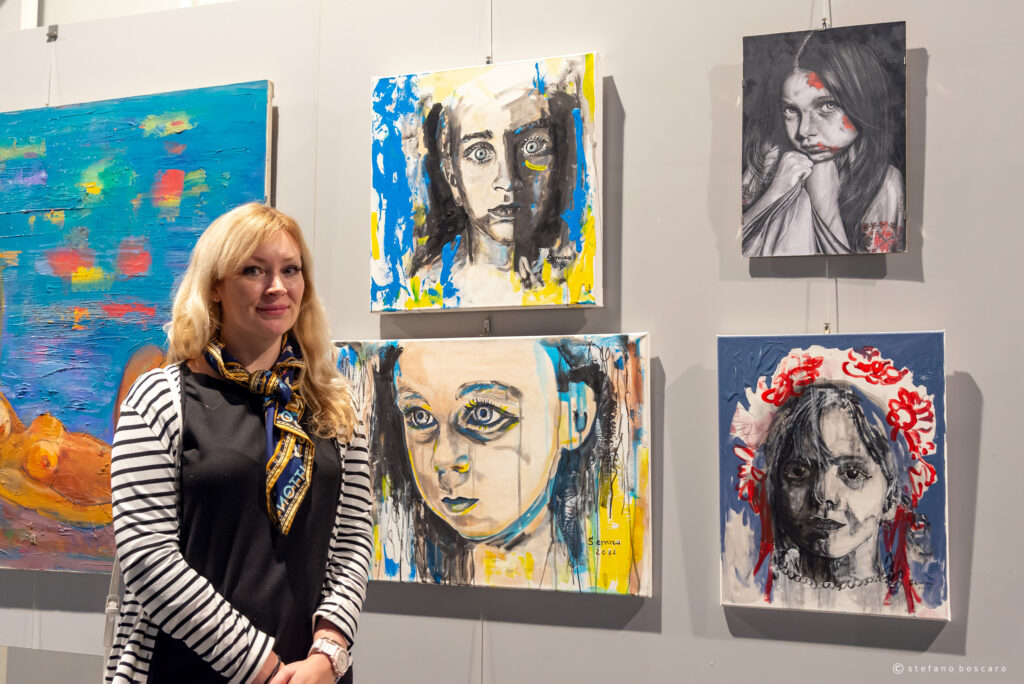

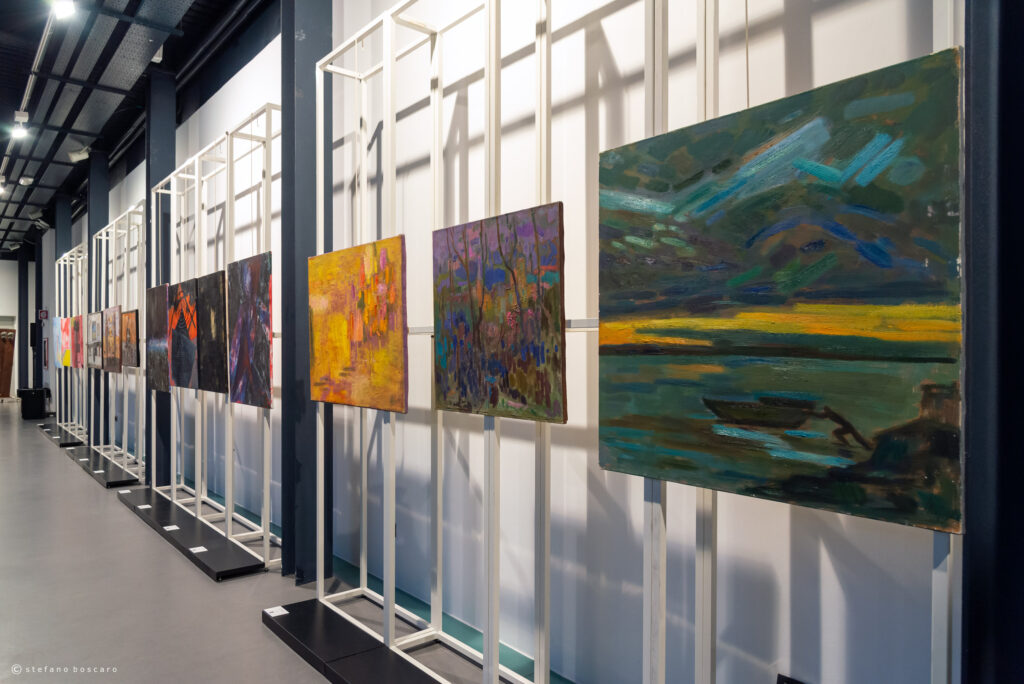
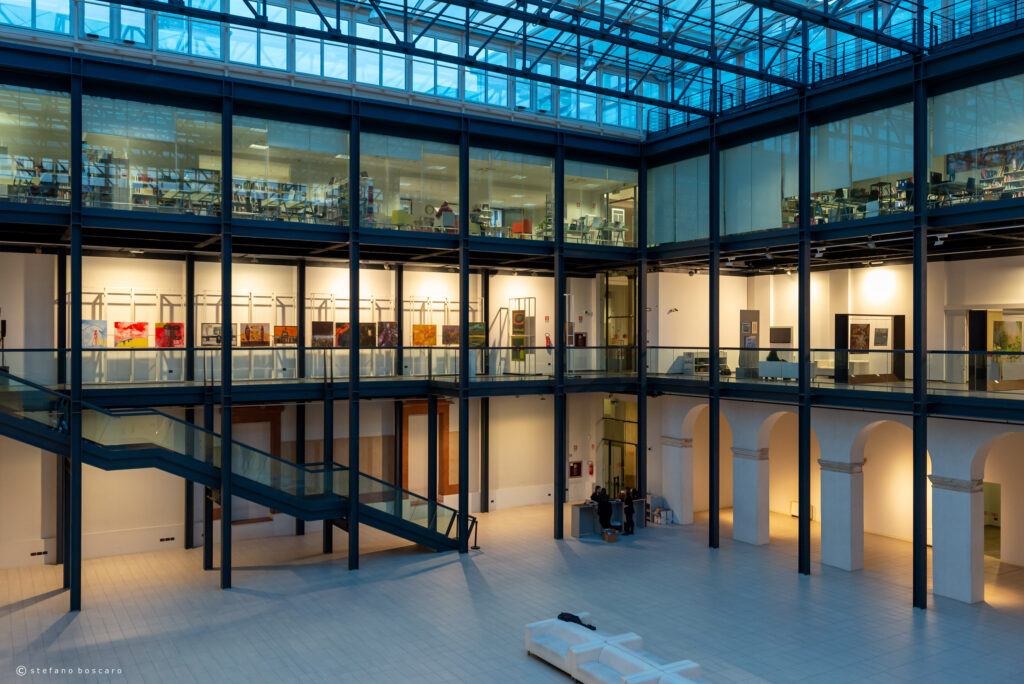
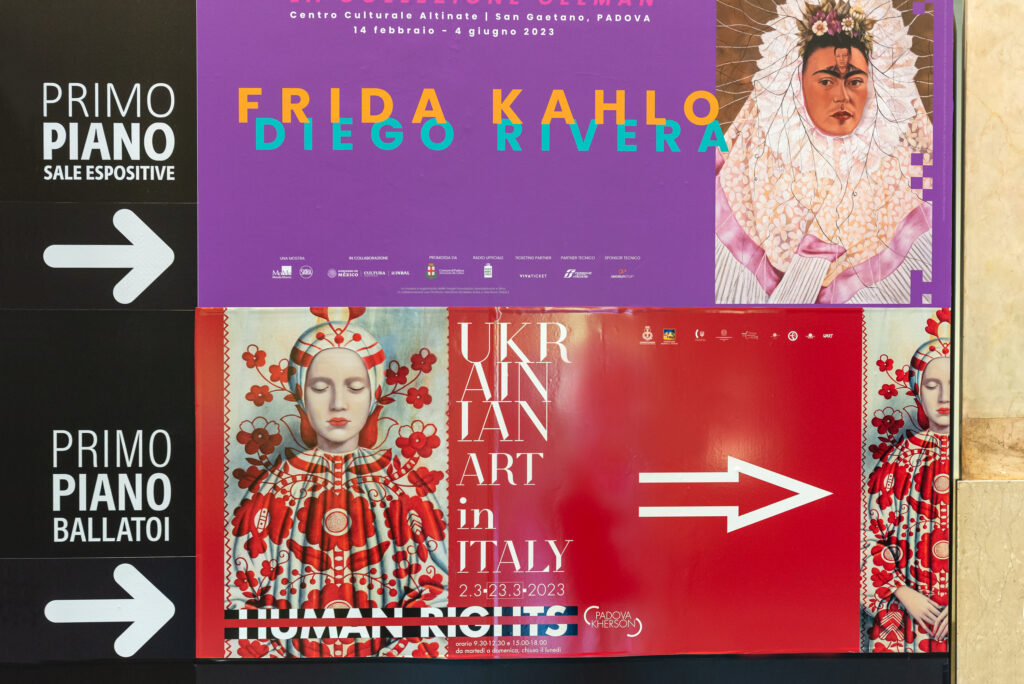
C.B.: Could you tell us about the artists who were invited?
L.V.: The works of 47 artists representing almost all important regions and artistic trends in Ukraine, as well as various generations of Ukrainian modern painting were presented: from very young artists such as Maxim Mazur (b. 1990 from Poltava), Anna Khodkova , (b. 1990 from the city of Shostka) to more mature painters such as Mykola Krivenko, (b. 1950 Kiev), Igor Prokofiev (b. 1960, who has a studio in the now sadly internationally known town of Bucha), Matvey Vaisberg (Kiev), Marian Luniv (Ivano-Frankivsk, Pre-Carpathian region), Anton Tarasiuk, Anton Logov (b. 1986, Odessa region).
Almost half of them are women, to name just a few: Olga Gritsenko, Olena Pridulodeva, Ksenia Datsiuk, Olesya Dzhuraeva, Olga Morozova, Olga Kovtun (the image selected for the poster of the exhibition), Rymma Vinogradova, Olya Haydamacka.
I would like to name them all, but it is impossible in the context of an interview so please refer you to the digital catalog of the exhibition. In addition to works by painters, the exhibition featured the sculpture “Dedicated to Children,” which was created by Italian sculptor Giampiero Cudin in memory of the child victims of this ongoing war.
Among the artists from the occupied city of Kherson, whose works are displayed in the exhibition, some fell in battle, such as the young painter Artem Azarov (b. 1995), whose 4 works we presented. We believe that for the artists involved, the possibility of being seen and heard through the exhibition is a kind of therapy, a form of redemption that can keep them strong, with a clear mind despite the reality they find outside their front door. For us it becomes an opportunity to tell about their struggle, a struggle with artistic tools of course, a chance to make them known to the world, so that their works speak for them.
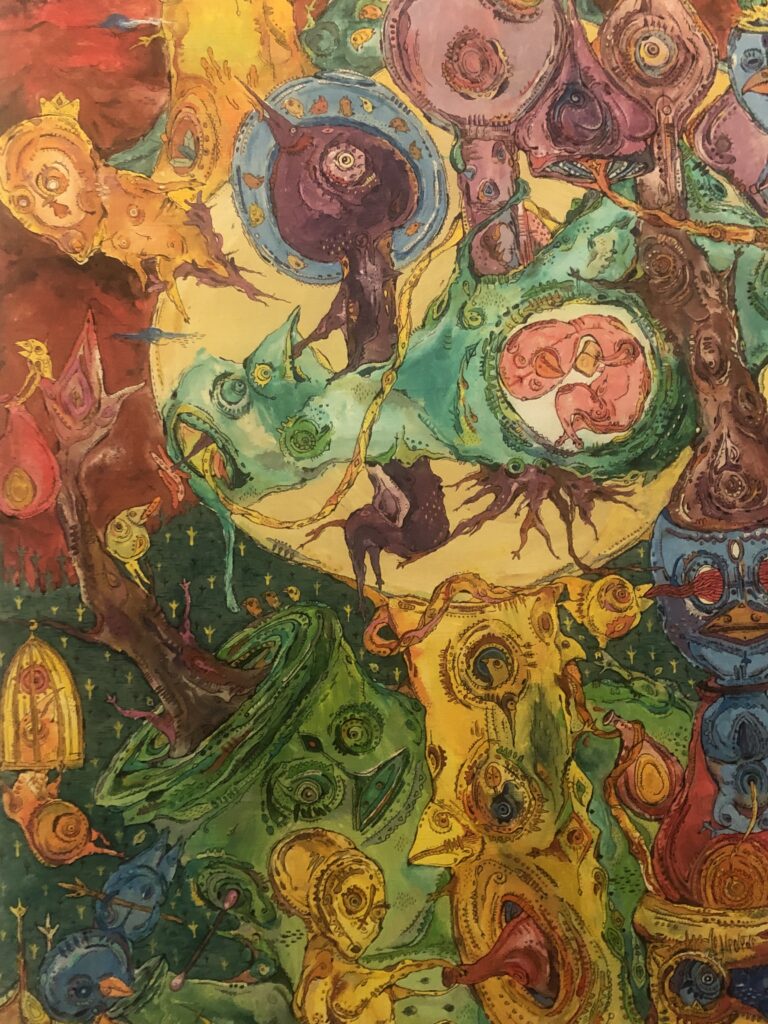
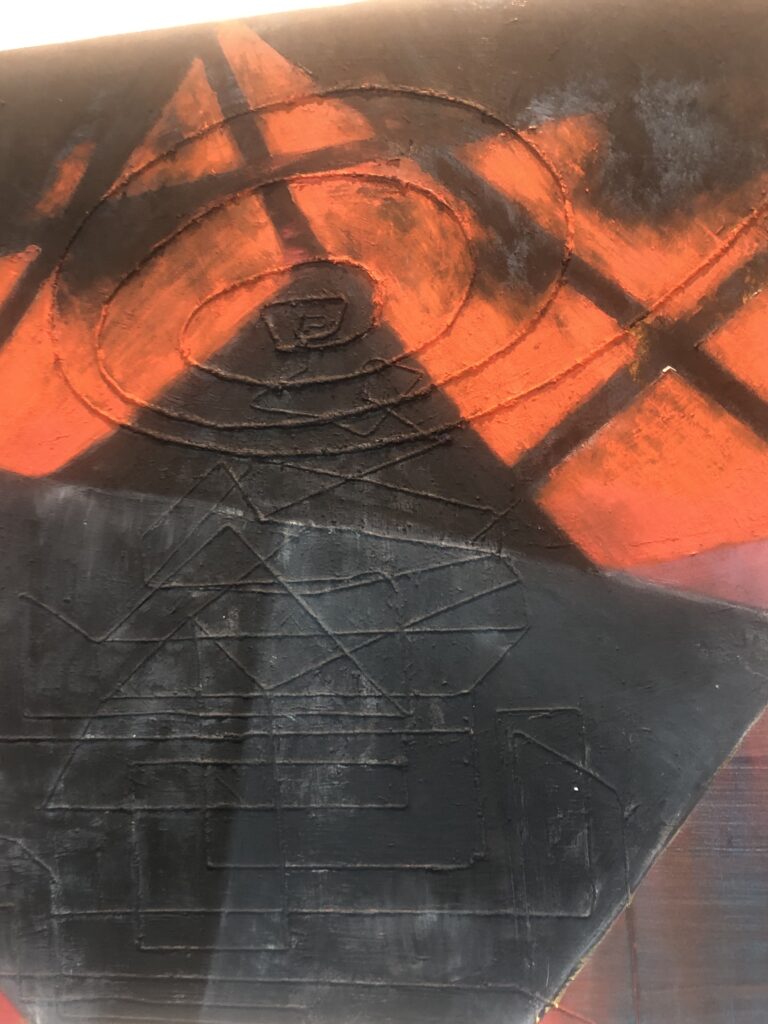
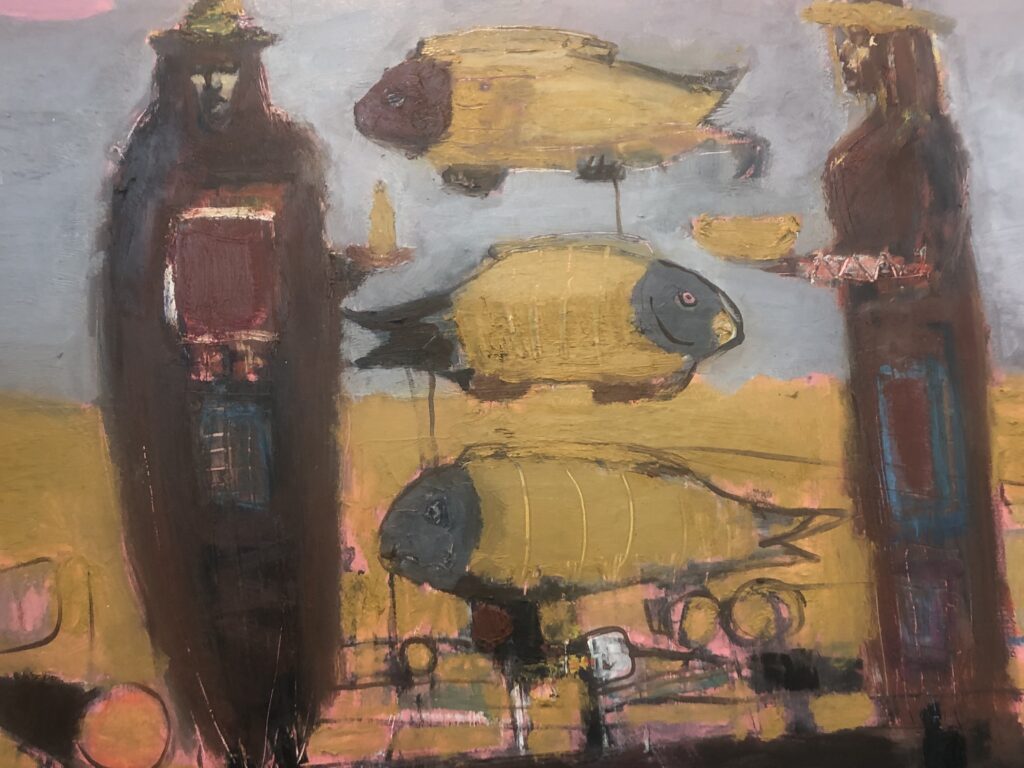
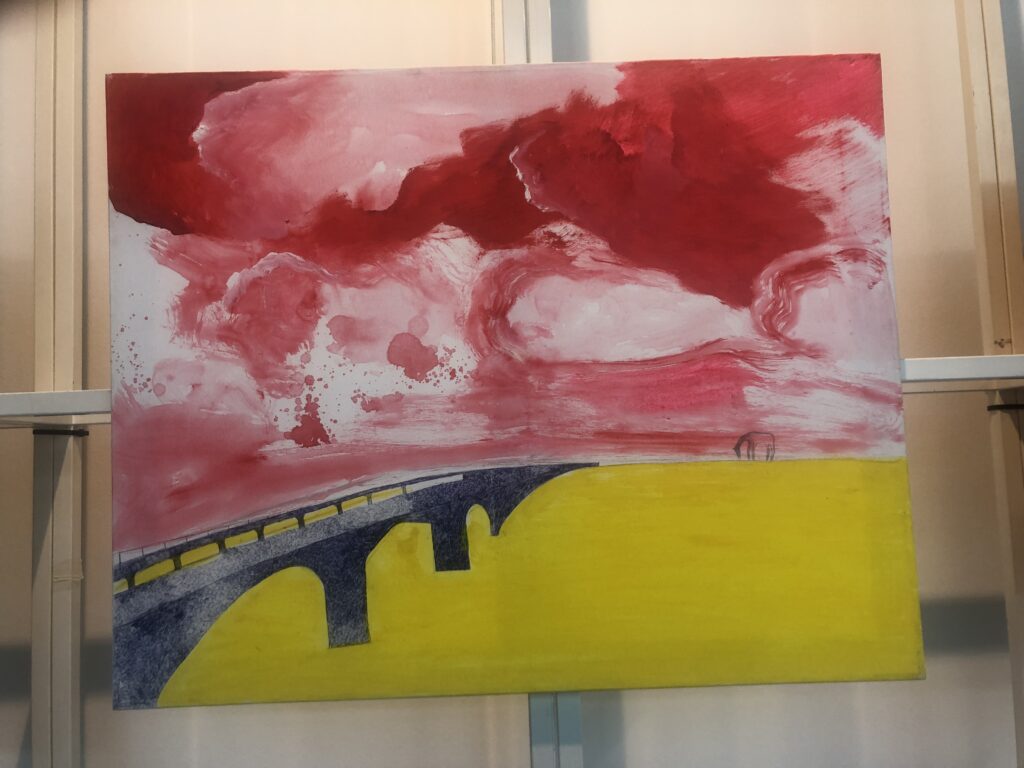
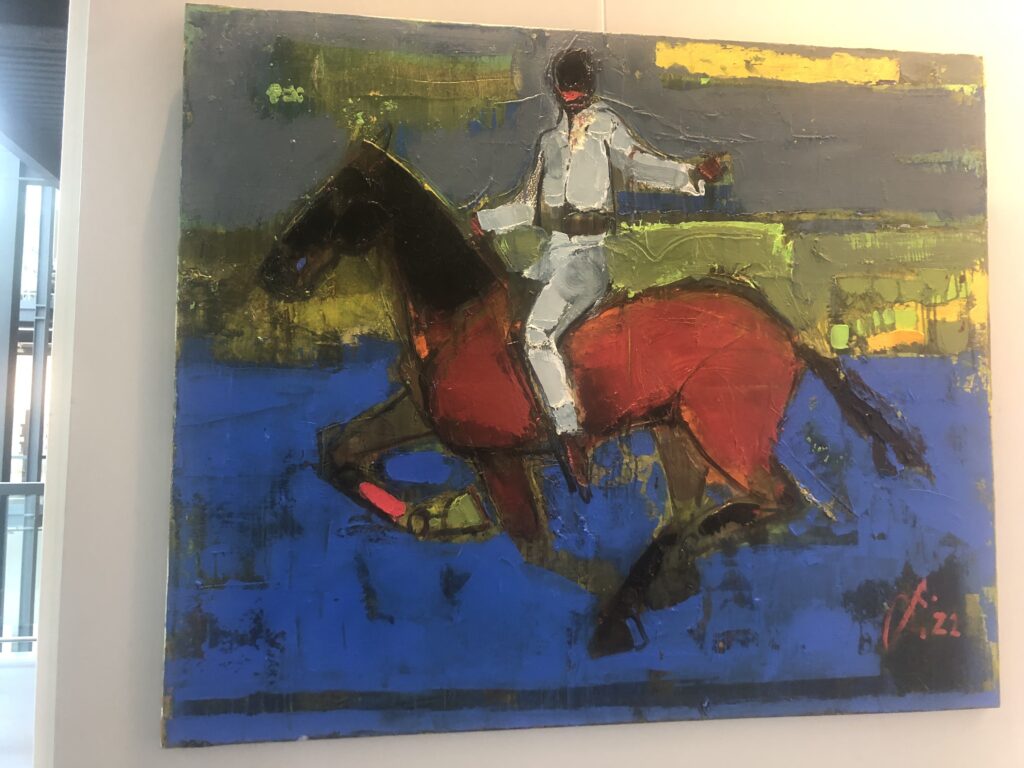

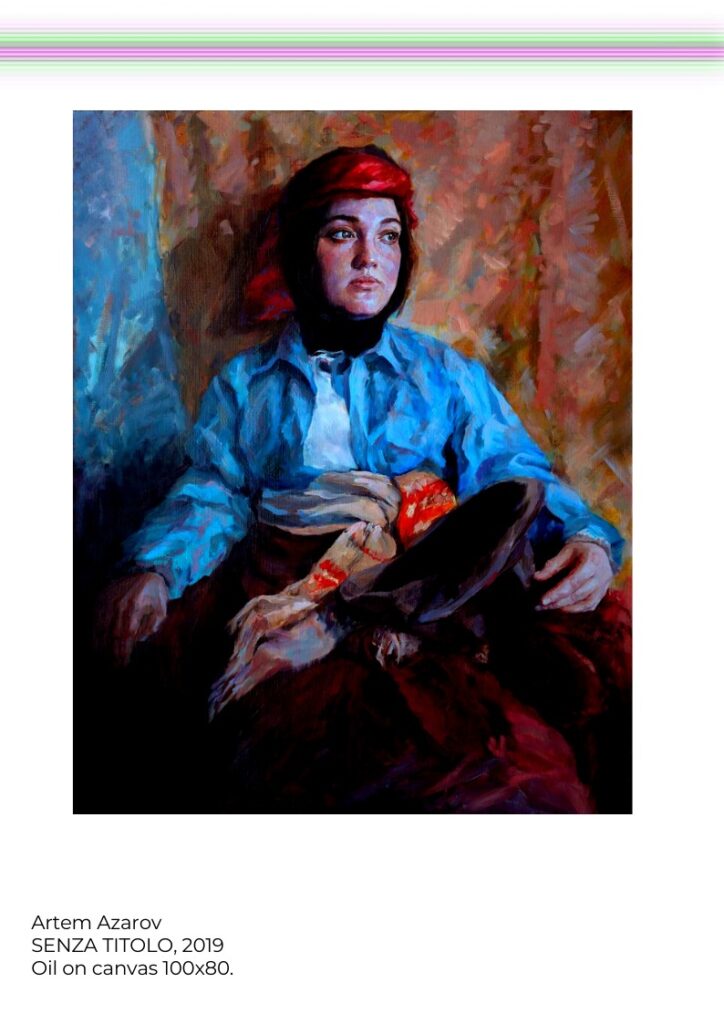
To identify the works that are photographed in this interview, please refer to the exhibition catalog
C.B.: Describe one work in particular.
L.V.: There are many works that I would like to talk about.
For the image of the exhibition, I chose “The Tree of Life” by Olga Kovtun, who is an established painter from Kiev, born in 1983.
The choice was an immediate one, and not only because of the aesthetic beauty of the work, or the delicate artistry of the artist’s painting, but because in my perception the work fully embodies the allegorical image of Ukraine at this tragic historical juncture.
It is an emblematic image, – a modern icon, the female archetype – Ukraine has always been associated with a woman, the symbolism of the very famous design of the embroidered Ukrainian shirts, which bears the same name “The Tree of Life,” the design transcends the figure of the woman herself making the whole ‘icon’ become a hope for life. The woman’s hands are laid down in a restrained gesture of patient and determined waiting, her eyes are closed so as not to see the horrors of the ongoing war, but in the serene certainty of the victory of life and Ukraine.
Modern art that creates a canon, contemporary issues resonating in the eternally recurring and fundamental themes of our existence, such as the importance of preserving life at any cost and everywhere.
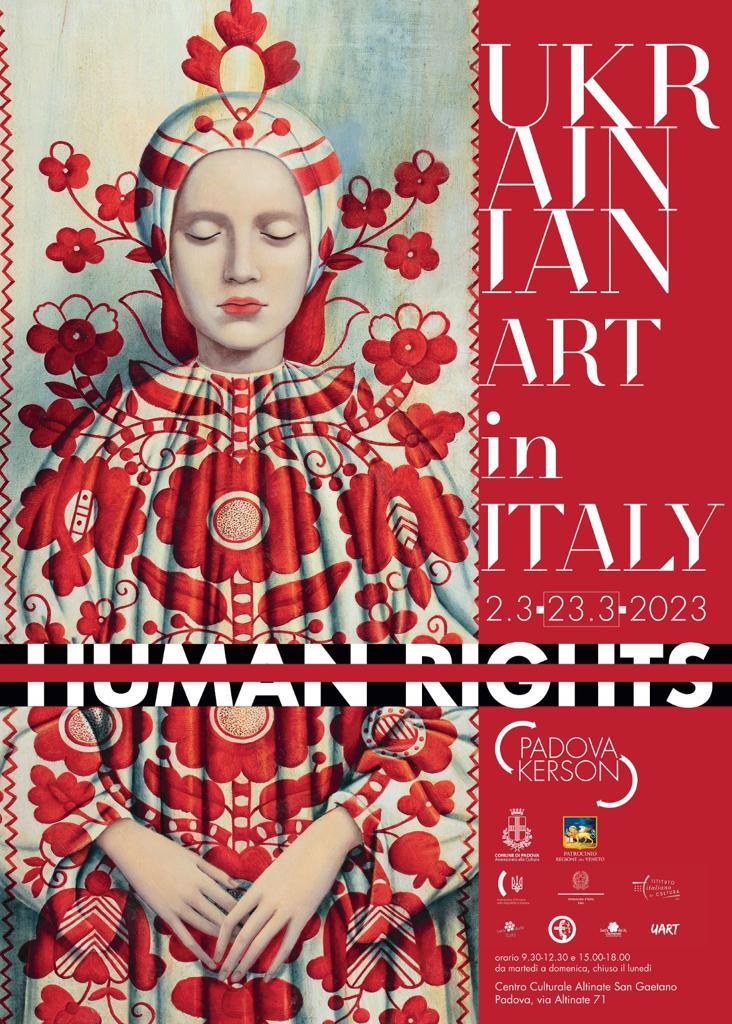
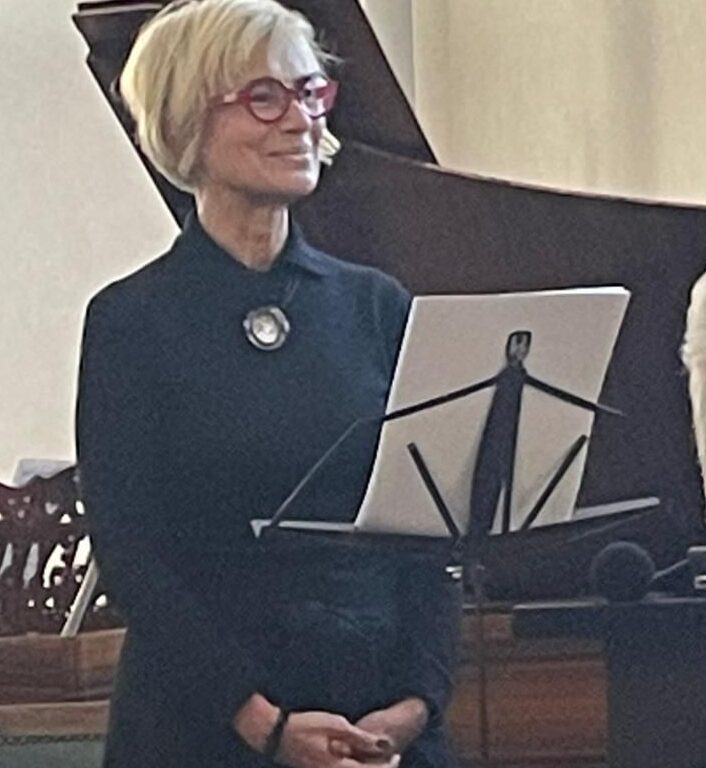
Liudmila Vladova Olenovych, born in Kyiv, Ukraine, has been living in Italy for more than 30 years. She is an interpreter, translator and entrepreneur in the fashion sector, has collaborated for many years with the Veneto Regional Administration for projects related to Ukraine, including the exhibition “L’Oro degli Sciti delle steppe ucraine” (The Gold of Scythians from the Ukrainian Steppes) at the Vicenza Civic Museum in 1995 and “La pittura Veneta del cinquecento” (Sixteenth Century Painting from the Veneto Region) organized in Kyiv in 1995. She is active in projects for the promotion of Ukrainian culture in the world and in Europe: The exhibit “Ukrainian Art in Padua – Kherson Human Rights (Erased)” is one of the results of her international cultural engagement in collaboration with the associations VITAUKR and Let’s Do It Ukraine and Let’s Do It Italy, with the sponsorship of the Padua Municipality – Cultural Department, the Veneto Regional Administration, the Ukrainian Embassy in Italy, The Italian Embassy in Kyiv and the Italian Cultural Institute in Kyiv.
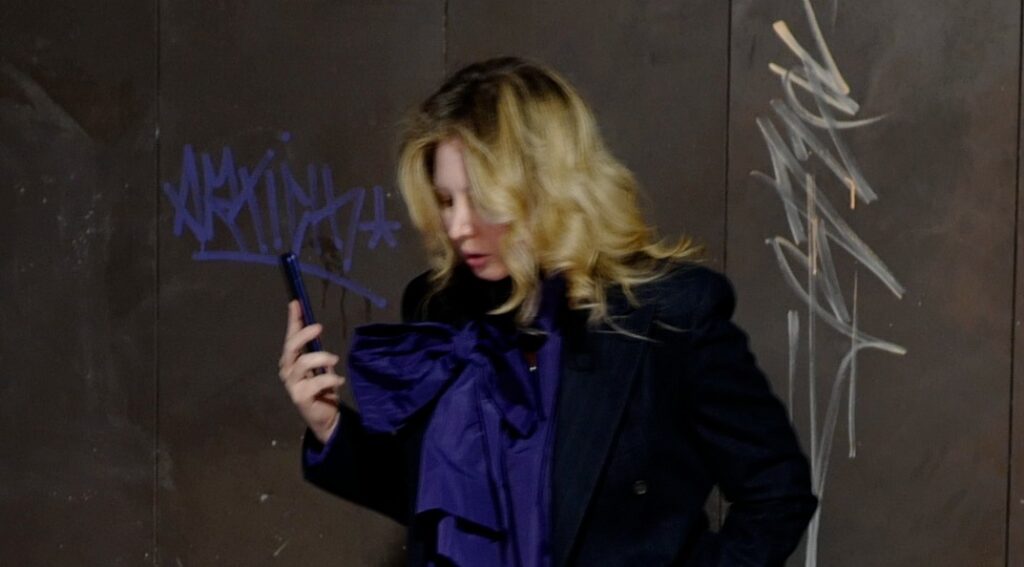
Camilla Boemio is an art writer and curator who has curated projects around the world, from Los Angeles to Odessa, Ukraine. She is a member of AICA (International Association of Arts Critics) and IKT (International). Her recent curatorial projects include: her role as associate curator at Pera + Flora + Fauna. The Story of Indigenousness and Ownership of History, an official Collateral Event at 59th International Art Exhibition: La Biennale di Venezia (2022); Jérôme Chazeix The coat of hipness (materiali velati) in Altaroma2020 agenda at Label201 (2020); Marina Moreno: Dance as sculpture in space supported by Arts Council England (2019-2020); The Contemplative Edge. Il MondoNuovo. a performative Parallel Event with artists Mathew Emmett and Greig Burgoyne at Museo dell’Arte Classica, in Rome (2022). In 2016, she was the curator of Diminished Capacity the first Nigerian Pavilion at the 15th International Architecture Exhibition La Biennale di Venezia; and in 2013 she was the co-associate curator of Portable Nation. Disappearance as work in Progress – Approaches to EcologicalRomanticism, the Maldives Pavilion at 55th International Art Exhibition La Biennale di Venezia. In 2018, she took part in the VVM at Tate Liverpool.


























































